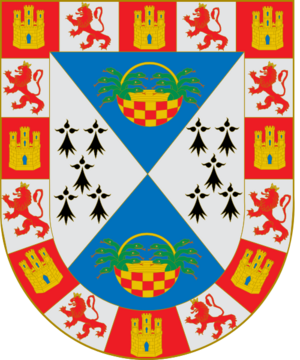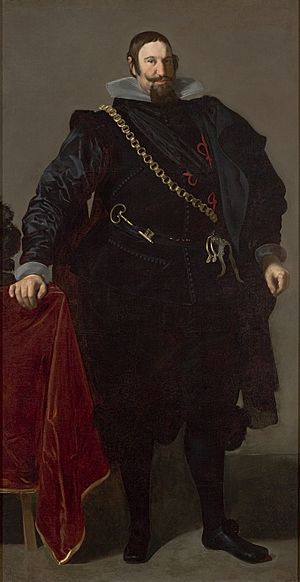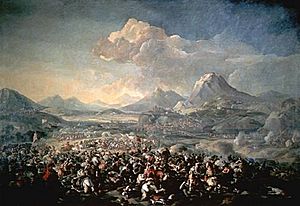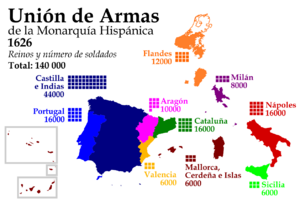Gaspar de Guzmán, Count-Duke of Olivares facts for kids
Quick facts for kids
The Most Excellent
The Count-Duke of Olivares
|
|
|---|---|
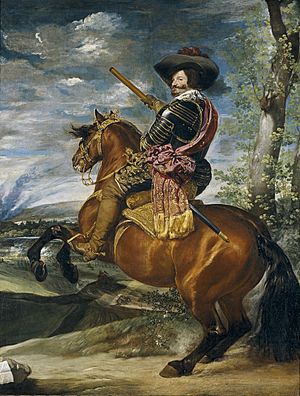
|
|
| Valido of the King of Spain | |
| In office 25 January 1622 – 23 January 1643 |
|
| Monarch | Philip IV |
| Preceded by | Baltasar de Zúñiga |
| Succeeded by | Luis de Haro |
| Personal details | |
| Born | 6 January 1587 Rome, Papal States |
| Died | 22 July 1645 (aged 58) Toro, Crown of Castile, Spain |
| Spouse | |
| Parents |
|
| Signature | |
Gaspar de Guzmán y Pimentel (born January 6, 1587 – died July 22, 1645) was a powerful Spanish politician. He was known as the Count-Duke of Olivares. This special title came from combining his inherited title of Count of Olivares with a new title, Duke of Sanlúcar la Mayor. He served as the main advisor, or valido, to King Philip IV for over 20 years.
Olivares was a very important figure in Spain during a time of many wars and big changes. He tried to make Spain stronger and more unified. However, his policies led to major conflicts and problems both inside and outside the country. These challenges eventually caused his downfall.
Contents
Becoming a Powerful Advisor
Gaspar de Guzmán was born in Rome in 1587. His father was a Spanish ambassador and came from an old noble family. Gaspar studied at Salamanca University in Spain. He was good at both academics and military skills.
He joined the royal household of Prince Philip, who later became King Philip IV. Gaspar's uncle, Don Baltasar de Zúñiga, helped him get this position. Olivares quickly became the young prince's most trusted advisor.
Taking Charge of the Kingdom
When Philip IV became king in 1621 at age 16, he trusted Olivares completely. The king ordered that all important papers should go to Olivares first. This made Olivares the most powerful person in the government. He was called the valido, which meant he was more than just a prime minister. He was the king's closest friend and partner in ruling.
Olivares inherited the title of Count of Olivares. King Philip IV also made him the Duke of Sanlúcar la Mayor. Olivares asked the king if he could keep both titles, which was very unusual. This is why he became known as the Count-Duke.
Olivares's Personality and Interests
Olivares was a very dedicated and serious person. He was described as having a "big, heavy body" and a "florid face." People saw him as determined, smart, and ambitious. He did not enjoy sports or light entertainment.
He was very passionate about his work. Olivares would wake up early, meet with the king, and then work long hours, often until late at night. He was also interested in astrology and promoted King Philip as "The Planet King."
Olivares did not collect art himself, but he helped King Philip build his famous art collection. He also introduced the young artist Diego Velázquez to the king in 1623. Velázquez painted several famous portraits of Olivares.
How Olivares Governed Spain
Olivares wanted to reform Spain and make it stronger. He believed Spain had declined under the previous king. He wanted to bring back the power and glory Spain had under King Philip II.
He saw Spain's problems as moral and spiritual. He also thought that people in Castile (the central part of Spain) did not like manual labor. For Olivares, Spain was all about the monarchy and King Philip IV.
Reforming the Government
Olivares believed that domestic policies should support foreign policy. He was very interested in astrology and used it in his political ideas. He promoted Philip as "The Planet King," using the sun as a symbol for the king.
He was known for his hard work. Olivares would start his day early, meet with the king, and then work late into the night. He lived a simple life himself. He also used the formal rules of the court to control his rivals.
To make decisions faster, Olivares created small government committees called juntas. Over time, he filled these committees with people who supported his policies. This created a mix of centralized power under Olivares and smaller committees doing the work.
As he got older, Olivares worked so much that he started to have sleeping problems and mental health issues. He became impatient and would get angry with those who disagreed with him.
Olivares's Foreign Policies
For 22 years, Olivares guided Spain's foreign policy. This was a time of constant war and many challenges for Spain. Olivares believed that other European countries were jealous of Spain and wanted to attack its power. He saw the Dutch as a main enemy.
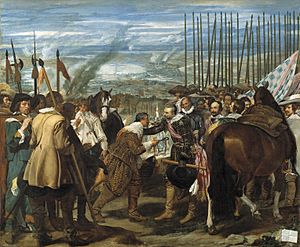
In 1621, Olivares made a big decision. Spain had been in a truce with the Dutch for 12 years. Olivares decided to end this truce and restart the war. He wanted to use the army and economic attacks to defeat the Dutch. This policy ultimately failed over the next 30 years.
For much of the Eighty Years' War, Olivares focused on the Netherlands first. He hoped to win there and then deal with other problems in Europe. For the first 15 years, this strategy worked well. Spain made progress against the Dutch, even retaking the city of Breda in 1624.
In 1634, Olivares helped create a new Spanish army in Italy. This army marched into Germany and won a big victory against Protestant forces at the Battle of Nördlingen (1634). Olivares thought this would help Spain attack the Dutch again.
War with France
Olivares's plans changed when France entered the war. His handling of the War of the Mantuan Succession in Italy led to conflict with France. By 1635, France declared war on Spain. Olivares told the king that this war with France would be an all-or-nothing fight.
In 1635, Olivares planned a huge invasion of France with four armies and two navies. Spanish forces got very close to Paris. However, this plan stretched Spain's resources too thin and eventually failed. Spain then faced a big counter-attack from France in 1637.
By 1639, Olivares tried to make peace with France, but he failed. He also thought about making a separate peace with the Dutch. But the Dutch had taken over Brazil, and Portugal did not want to give up its colony. This made peace impossible. The Spanish fleet was also destroyed at the Battle of the Downs, which was a major blow.
Olivares's Domestic Policies
Olivares saw Spain as a collection of different kingdoms and regions. These included Castile, Aragon, Portugal, and Catalonia. Each region had different taxes, privileges, and military rules. Castile had more privileges, which caused problems with other regions.
By the 1620s and 1630s, Castile could not provide any more money for the wars. New ways to raise money were needed. Olivares worried about Spain's decline. He thought that Catalonia and other regions were not paying enough to the crown. He believed they should contribute more to defend Spain.
The Union of Arms
In 1624, Olivares proposed his "Union of Arms" plan. This plan asked each part of Spain's territories to provide a certain number of soldiers based on their size. Olivares presented it as a military plan, but it was also meant to unify Spain more closely.
The "Union of Arms" plan faced strong opposition, especially from Catalonia. Olivares even offered to resign in 1626, but the king did not accept. Spain continued to face financial challenges. In 1627, Olivares tried to deal with Spain's bankers by declaring a state bankruptcy.
This plan did not work well. In 1628, the Spanish treasure fleet was captured by the Dutch. This made it harder for Spain to borrow and move money around Europe. When the Dutch took over Brazil, Olivares tried to raise taxes in Portugal in 1637 to pay for a mission to get the colony back. This led to a small uprising in Portugal.
Revolts and Downfall
The last years of Olivares's rule were marked by major revolts in Catalonia and Portugal. In 1640, Olivares sent an army into Catalonia, expecting little resistance. Instead, a major revolt broke out. Later that year, Portugal also rebelled, declaring its independence from Spain.
Olivares's Fall from Power
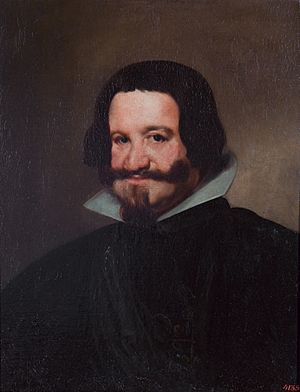
Olivares's power began to weaken for several reasons. The revolts in Catalonia and Portugal were the most immediate cause. They threatened the stability of Spain itself. Olivares also started to suffer from mental health problems in his later years, which affected his ability to govern.
He had also upset many other nobles in Castile. His use of small committees, filled with his own supporters, annoyed many people. Olivares was also blamed for the high cost of the new royal palace, the Buen Retiro Palace. This seemed to go against his own ideas of saving money.
In 1641, there was a bad period of inflation, which caused economic problems. The Spanish people generally blamed Olivares for the country's misfortunes in the 1640s.
Olivares did not want to give up power easily. He tried to use art and theater to gain popularity, but it did not work. He managed to stop a plot against him in 1641. However, his situation worsened as the Catalan revolt continued.
In 1626, Olivares's nephew, daughter, and baby had all died. In 1641, he made his illegitimate son, Don Enrique Felipez de Guzman, his legal heir. This upset another nephew who was supposed to inherit. King Philip IV realized he might have to remove Olivares to protect the royal family's popularity.
The king finally removed Olivares from power in January 1643, pressured by a court plot led by Queen Isabel. Olivares retired to Loeches, where he published a defense of his actions. His rivals felt he was still too close to the court, so he was moved to his sister's palace in Toro.
He continued to work, even helping with the local government in Toro. He died in 1645, suffering from increasing mental illness. After his death, his large collection of papers was mostly destroyed in a fire.
For a long time, many people in Spain saw Olivares as a greedy and ineffective leader. However, modern historians have started to change this view, seeing him as a more complex and determined figure.
See also
 In Spanish: Conde-duque de Olivares para niños
In Spanish: Conde-duque de Olivares para niños
- History of Spain
- Thirty Years' War
- Portrait of the Count-Duke of Olivares (disambiguation)
Images for kids


